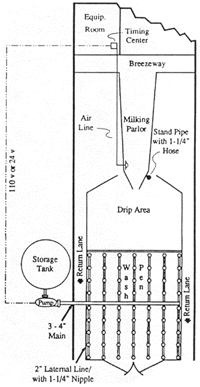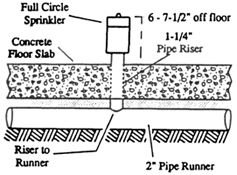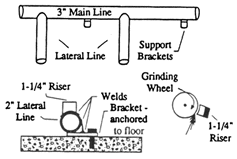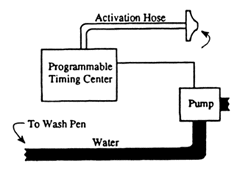
Planning
Related Sites to the Dairy Industry
For more information please contact us at:
E-Mail: info@cowwasher.com
Cowwasher Co.
PO Box 113
Oracle, AZ 85623
Telephone: 916-608-1744
US Only: 800-645-7458
Introduction
Principals Of Good Milking Parlor Practice.
Research has proven the value of wash pens. Dirty cows increase prep time an average of 16 seconds per cow, and use of a wash
pen increases throughput by 8% - 21%, depending on parlor size. In designing your wash pen and drip pen, keep these facts in mind.
Cows should enter the parlor straight ahead and turn when exiting.
Crowd gates between the wash pen and drip pen can improve throughput by as much as 5%. Herds that are milked 3X daily should not
be held in the wash/drip pens for more than one hour per milking. Never hold cows longer than 2 hours.
Be sure there is good lighting in both the wash pen and the parlor. Cows don't like the contrast of going from a lighted to
a darker area.
 Wash Pen Design and Layout
Wash Pen Design and Layout
Locate pump, water storage so as to eliminate unnecessary pipe runs and turns.
The layout to the right is not meant to be typical of dairies in general, but rather to illustrate how the location of the wash pen can influence its effectiveness and construction cost. By experimenting with alternatives the dairyman will ultimately discover the configuration that reduces expensive piping and electrical lines, while increasing the efficiency of the entire operation.
Design the wash pen to allow 14 sq. ft. for each cow.
Cows are stressed by crowding, and stressed cows require longer milking times to produce less milk. If cows are allowed
about 13 1/2 to 14 square feet of wash pen space apiece, they are more likely to be clean and placid when they enter the parlor.
In laying out wash heads, keep each side row as close as possible to the fence. (If a cow gets between the side row and the
fence, she will be washed on one side only!). Space wash heads on a 5'X5', 5'X6", or 5'X7' grid, whichever provides the most
effecient layout.
 Run water lines under the wash pen floor or anchor securely to concrete.
Run water lines under the wash pen floor or anchor securely to concrete.
The pipe grid should be laid on a bed of sand under a concrete slab.
 Modifications to existing structure.
Modifications to existing structure.
When retrofitting an existing floor, pipes must be welded to brackets which raise them off the floor and provide a means of
anchoring them to concrete.
 Use sheet metal siding along return aisles or use 1/2-circle wash heads on side rows.
Use sheet metal siding along return aisles or use 1/2-circle wash heads on side rows.
To prevent returning cows from being sprayed with water, weld sheet metal to the fence to within 6" of the floor, or fit
side rows with 1 1/2 circle wash heads. Use 1/4 circle wash heads in wash pen corners.
 Timing Center
Timing Center
A wash/soak/rinse timing device that can be programmed to use the optimum amount of water for the mud condition of the cows can save thousands of gallons of water per month.
NOTE! If you have
an appreciable amount of sand in your water it could disable your wash heads! Install a filtering system.
Water Pump Selection
Determining the size of the water pump required by the wash pen involves calculating pipe size, length of pipe runs, number and type of fittings, and the number of wash heads. Use the following table to select the proper water pump.
| Wash Pen Capacity | # of Wash Heads | GPM Required | Booster Pump Size |
|
50-86 cows 86-118 cows 118-161 cows 161-214 cows |
24-40 40-55 55-75 75-100 |
125-200 200-275 275-375 375-500 |
7 1/2 H.P. 10 H.P. 15 H.P 20 H.P |
* Based on 30' sq. ft. spacing of wash heads and 14 sq. ft. of wash pen space/cow.
NOTE! To maintain proper water pressure at the wash heads (35-50 PSI), a flow control valve with a water return line must be installed in the main service line between the pump and the wash pen. Failure to install a water return line will cause a back pressure on the pump. The operating pressure at the wash heads can be determined by taking a water gauge reading at the farthest point from the water pump in the wash pen. This gauge can be assembled by placing a 1/4" tap in the top of the wash head body and inserting a water pressure gauge.
| Home | Planning | Installation | Spanish |
Copyright © 2021
.......................................................................